
WHAT IS THE DIFFERENCE BETWEEN RUNNING AND TRAINING SHOES?
Running and training shoes may look similar, but the key differences are in sole flexibility and heel drop.
- Running shoes are built for heel-to-toe movement and the higher heel drop in running shoes comes from added support and cushioning. Take these shoes on tracks and runs.
- Training shoes are for multi-directional movement, especially lateral (side-to-side) movement. The sole of a training shoe is flatter, making it more flexible to allow a wide range of movement. Take these shoes to the gym.
WHAT ARE RUNNING SHOES BEST FOR?
This one is more obvious – running shoes are for running. But how do running shoes help with running? Running shoes protect your feet when pounding the pavement over and over again. Where a training shoe helps with side-to-side movement, running shoes help with forward movement. Running shoes also provide more cushioning and support, which often translates into a higher heel drop. This makes for more comfort during long distance runs when you need lots of shock absorption.
WHAT ARE TRAINING SHOES?
Training shoes support a range of movement, including: cutting, stopping, breaking, jumping, and changing direction quickly.
This makes a training shoe versatile and good for many different types of workouts. You can think of training shoes as your all-in-one gym shoe.
You can usually tell a shoe is a training shoe by how much flatter the shoe is. The technical term here is the “heel drop,” which refers to the distance from the heel height to the toe height.
WHAT ARE TRAINING SHOES GOOD FOR:
- High-intensity gym classes and outdoor boot camps – cushioning for high-impact and run training
- Weight lifting – heel support so you can go lower into squats and then stand up
- Strength training – a training-specific last makes for extra space in the forefoot
- Agility training – grooves and outsole patterns for traction during plyometric and multi-directional movement
You can even do short distances on a treadmill. Anything longer than a 5K is usually better with running shoes for shock absorption.
HOW SHOULD TRAINING SHOES FIT?
Training shoes have a comfortable upper and flexible midsole for multi-directional movement. A lower heel drop puts you closer to the ground to push off and pivot. Training shoes are lightweight for easy and efficient movement.
RISKS OF USING THE WRONG SHOES FOR YOUR WORKOUT
Wearing the wrong shoes may lead to problems such as:
- Discomfort
- Lowered performance
- Injuries
DISCOMFORT
The wrong type of shoes can cause discomfort in many different ways. You may experience blisters, aches and pains, or soreness. It may be the reason your shoe doesn’t feel quite right. The best shoes don’t get in your way at all – letting you do your workout without hardly noticing them.
LOWERED PERFORMANCE
Wearing the wrong type of shoe can keep you from performing your best. When you’re putting in the hard work to get better, the last thing you need is your shoe to be holding you back. Running shoes during plyometrics can keep you from pivoting quickly. You won’t have the grip, traction, and flexibility of the sole a training shoe provides. Without running shoe cushioning and support, it may be harder to up mileage or get faster.
INJURIES
Running and training shoes provide specific types of support to prevent injury. Here are some of the ways a mismatch of shoe to workout may increase your chances of injury:
- Running shoes for lateral movement: higher heel drops make for a higher chance of ankle sprains during lateral movement
- Running shoes for plyometric workouts: the extra cushioning and support from running shoes can keep you from landing properly and can increase your chances of a knee or ankle injury
- Running in training shoes: without the cushioning and support of running shoes, you can increase your chances of getting plantar fasciitis
- Not enough running support: stress fractures can occur from running without proper support, which can happen when using minimalist shoes lacking cushioning to absorb shock
- The wrong type of running shoes: tendonitis can happen when you aren’t wearing the running shoe for your pronation type – whether it’s an overpronator needing a more structured shoe or a neutral runner wearing a shoe with too much arch support
- Lifting weights in cushioned shoes – it’s best to do lifting in shoes with little cushioning
Don’t forget shoe size. Too small of shoes can cause your toenails to turn black from bruising and fall off. You should be sizing up at least a half size to account for the natural movement and swelling of your feet during workouts. You may also need to find the right shoe width for your comfort.
If you’re still unsure about what shoe is best for you, find an ASICS retail store for expert guidance or your local specialty sports store.
This blog was originally written for ASICS, and can be found HERE







